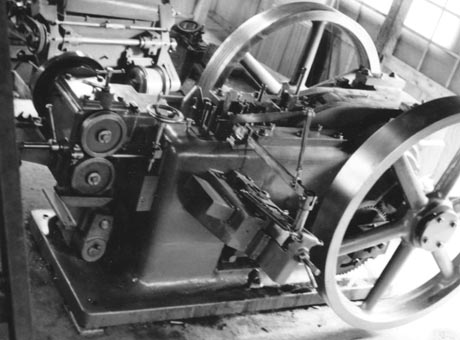History
1947
The founder, Yoshikazu Sakamura, began cold header production and sales in Minami Ward, Osaka.

1955
The first domestic (Japanese) bolt former was developed.
(PAT NO. 262267)

1959
Sakamura Machine Co., Ltd. was established.

1961
Sakamura received the Aida Press Technology Award for “Transfer Header Design and Manufacturing.”
1965
The die department was separated from Sakamura Industries Inc.
An NP nut former with a three die station was developed and recognized as “a revolution in the nut production industry.”
An NP nut former with a three die station was developed and recognized as “a revolution in the nut production industry.”

1968
The Kyoto plant was newly established in Kumiyama, Kuse, Kyoto.
The HNP two-piece ram hot former was developed.
The HNP two-piece ram hot former was developed.
1969
Tokyo Sakamura Machine Co., Ltd. was established.
1973
The HBP hot former, which forges inner and outer bearing races simultaneously, was developed.
1976
Fuse Sakamura Machine Co., Ltd. was established.
1979
Sakamura Seiatsu Co., Ltd. was established and the manufacturing and sales of hot forging parts began.
1982
Japan’s first individual tool change robot was developed.

1984
The FR-325 unit with a built-in thread rolling mechanism was developed.
1989
The AMTC robot, which can freely select and change a single die or a series of dies, was developed.

1990
The APT transfer system with improved working characteristics was developed.
Sakamura received an award from the Minister of Science and Technology for the “Development and Fostering of Plastic Forming Technology for Metallic Parts.”
Sakamura received an award from the Minister of Science and Technology for the “Development and Fostering of Plastic Forming Technology for Metallic Parts.”
1993
Sakamura received the Yellow Ribbon Medal for using formers in the design and improvement of plastic forming methods for metallic parts.

1994
Sakamura Technology Center Co., Ltd. was established.
A dent prevention system, SP, which places products on a conveyor that passes through the machine frame, was developed.
A dent prevention system, SP, which places products on a conveyor that passes through the machine frame, was developed.

1997
SAKAMURA U.S.A., INC. was established.
The industry’s largest robot former (with a diameter of 330 mm) was developed.
The industry’s largest robot former (with a diameter of 330 mm) was developed.
1998
A fully enclosed die forging method (using formers) for bevel gears and tripods was developed.
1999
The Nagoya office was separated to establish Tokai Sakamura Co., Ltd.
Sakamura Hot Art Co., Ltd. and Sakamura Engineering Co., Ltd. were established.
The Sakamura Seiatsu Co., Ltd. plant was moved to a new location in Yawata.
Sakamura Hot Art Co., Ltd. and Sakamura Engineering Co., Ltd. were established.
The Sakamura Seiatsu Co., Ltd. plant was moved to a new location in Yawata.
2000
A seven-die station former was developed.

2003
The industry's first tapping former was developed.
2005
A forming method, which forms washers together with TC bolts without producing scrap, was developed.
A revolver guide pipe, which rotates and switches guide pipes with different wire diameters, was developed.
A revolver guide pipe, which rotates and switches guide pipes with different wire diameters, was developed.
2007
A high speed block change “SK-Type” robot was developed.
2008
An ultra large hot former with 21,000kN forging capacity was completed.
2009
The jog dial system, which enables a former to be operated by a jog dial, was developed.
2011
An ultra large cold former with 1,3000kN forging capacity was completed.

2012
The innovation former, which was designed to a compact size and does not require an operation platform, was developed.

2013
An office was opened in Shanghai, China.
2014
With our partner, Redimo, the Japanese-German co-production machine, BPF-625SS, was completed.
2017
Exhibited Former is equipped with servo motor drive at MF-Tokyo.

2018
The SP robot line can package the products without any scratches or dents was developed.
2019
The safer coil binder was developed to cut the band of coil safely.

2021
Sakamura received an award at the Japanese Society for Technology of Plasticity for “Forging methods of hydraulic system with Servo Drive equipped Former”.



